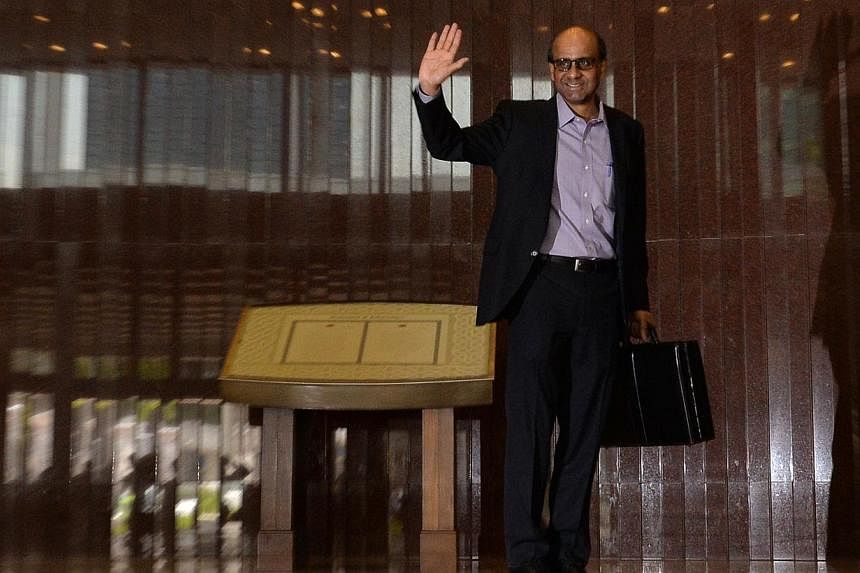When Deputy Prime Minister Tharman Shanmugaratnam's Budget statement last week did not crescendo in an announcement of cash handouts for every Singaporean, hopes for a 2015 General Election (GE) seemed to dim.
Before the last two GEs in May 2006 and May 2011, up to $800 in cash was handed out to every Singaporean in the February Budgets of those years.
Credit Suisse economist Michael Wan thus summed up the general reaction to Monday's Budget by noting: "There were no significant cash handouts given out in this Budget. This may suggest that the likelihood of an election this year is not as high as many observers think."
Perhaps so. But there are three major reasons why Budget 2015 could still be an election-year Budget.
The first is that the link people draw between Budget hongbao and elections has always been a crude one that's perhaps a little too cynical about the People's Action Party (PAP) Government's thinking.
The extra cash given out in the last two election-year Budgets had more to do with consistent surpluses than sweetening the ground - although any such effect would surely have been welcomed.
Those Budgets in 2006 and 2011 were the last ones before the constitutional deadlines for a GE, which were June 2007 and February 2012 respectively.
And since surpluses earned in one term of government cannot be carried over to the next, the Government chose to distribute its end-of-term surplus back to Singaporeans in the most eye-catching manner possible: handouts for everyone.
That cash, in turn, stemmed from an era in which the Government consistently earned more than it spent.
That era is likely to be over. Mr Tharman made it clear on Monday that Singapore is entering a different phase - of hiking spending and having to raise its revenues to match that.
Over the next five years, spending is projected to outstrip today's revenue on average by 1 per cent of gross domestic product, a projection Singapore has not encountered for decades.
This is our new fiscal normal, and the Government has had to hike taxes on the rich and draw more contributions from Temasek Holdings to balance the Budget.
If the GE is held this year, the current Government would end its term with an unspent surplus of about $4 billion - the difference between the $10.7 billion it has accumulated in surpluses since 2011 and the $6.7 billion deficit it will run this year.
By choosing not to redistribute this amount in cash, the Government would commit it to the reserves, which cannot be used for daily spending.
But perhaps the Government has judged that the national coffers could use such an injection considering the spending trajectory we are just at the start of.
The second major reason this Budget could herald a GE is because of its focus on the middle class.
Long the most fickle voting bloc, the middle class is hideously difficult to court.
While the poor worry about their needs and the rich can afford all their wants, the middle class is liable to confuse their wants for needs - and what they want always seems just an inch out of reach.
No centrist party can win an election without the middle class voter. Yet their desires are not urgent enough to be addressed first by any government that prides itself on objective policymaking, and too complex to be tackled in one blow. So the emergence of a middle class Budget is usually seen as a sign that hustings are nigh.
Dollar for dollar, the 2015 Budget is actually more generous to the broad middle than the 2011 one. Compare the tax rebates, for one: in 2011, taxpayers got a 20 per cent rebate of up to $2,000.
This year, they will get a 50 per cent rebate of up to $1,000, which is designed to be more generous to those who pay smaller amounts of tax.
Amounting to $717 million, this year's rebates will cost the Government more than the $580 million of rebates in 2011.
There was also an obvious effort to avoid inflicting pain on any segment in the broad middle, from halting temporarily the rise in foreign worker levies to halving the domestic helper levy.
Petrol duties were hiked, but that took advantage of historically low oil prices to mitigate the impact.
Only the super-rich were hit with a 2 percentage point rise in income tax - a move that is, if you think about it, a middle-class pleaser.
Then there is the $500 each adult Singaporean will get in his or her SkillsFuture account to put towards continuing education. This measure is expected to most benefit the middle class, who need more skills training to stay relevant as their jobs are threatened by technological advances and global competition.
The credit can also be seen as basically a universal handout, even if it is not in cash.
In fact, cash handouts in 2011 did nothing to dilute rising anxiety about foreigners, housing prices, or living costs, as seen in the PAP's historically low vote share during that year's GE.
Singaporeans have shown, time and again, that they vote based on their comfort level with the country's direction.
That is the third reason Budget 2015 could be an election-year Budget.
Its headliner measures - a Silver Support Scheme that gives cash to low-income retirees and a SkillsFuture initiative to help workers remain relevant - paved the last missing bricks of the PAP Government's shift leftwards towards a "compassionate and inclusive" social system.
Every Budget since the 2011 GE has put in place another section of what Prime Minister Lee Hsien Loong formally termed the "new way forward" in his 2013 National Day Rally.
In that speech, Mr Lee gave a name to the shift that began after the 2011 GE. Its old balance between Government and community support and individual effort was no longer adequate, he said, adding: "We must shift the balance. The community and the Government will have to do more to support individuals."
The social policies came fast and furious: MediShield Life for health insurance for all; Wage Credits to subsidise employers to hire the poor and old; the Pioneer Generation Package to take care of the frontier cohort; the Silver Support Scheme to entrench a basic pension for the poorest elderly.
This has been a massive expansion of social support. But it is important to realise that it is not a blind copying of the arcs of other developed countries.
Rather, the PAP Government has been sketching out its unique vision of what an inclusive and compassionate society looks like. This weaves together policies cleaving to what Mr Tharman has called "the paradox of active government support for self-reliance".
Certain new taboos have clearly emerged, like the aversion to universal entitlements. The Silver Support Scheme, for example, caters only to the poorest elderly and should not be seen as the first step towards a universal basic pension. This is the hard edge of the PAP's leftwards path: entitlements will only be for the poorest - not for everyone.
What is important to see is that the Government has not responded to Singaporeans' call for more social support with blanket largesse.
It is trying to navigate a compassionate and inclusive way forward without fiscal profligacy and societal sap - to walk a tightrope that almost no other country has successfully traversed before.
At the start of this term of government, the PAP said that it would chart a new way forward for the country.
Step by step, it has put its legislative agenda in place and we can now see clearly what the first iteration of this looks like. Only one question remains: what voters think.
Now is the time for the PAP to call a referendum on what it has achieved since its wake-up call in 2011, and for the Singapore voter to respond in the only way that matters.


